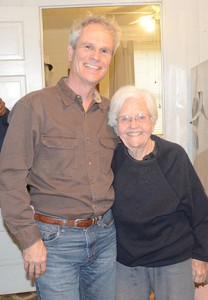
At age 90, Esther Lehmann (right, with writer Phil Houseal) relishes telling stories of her father Willie and her uncle Herman, who were captured by the Apache near Loyal Valley in 1870.
by Phil Houseal
Jan 15, 2014
NOTE: Thanks to an invitation from Clifton Fifer, retired history teacher, and popular re-enactor, and Paula Reynolds, who is working on a book about Esther, I was able to spend an afternoon interviewing Esther Lehmann, 90-year-old niece of Herman Lehmann, the famed German boy who lived 8 years with the Apache and Comanche. This is the second of two columns. Read previous column…
Esther Lehmann never really knew if her uncle Herman was happy back in his German home. One effect of his Indian upbringing was a reluctance to show emotion.
“I think he was happy, but I can’t say he was outgoing,” she remembered. “He didn’t do a lot of laughing, but I never knew him to complain.”
Of course life was hard around the German settlements in the 1920s and 30s. Going the 25 miles to town was a “four times a year” event in their Model T, when they would load up on supplies and the big treat was getting an ice cream cone.
“There wasn’t much fun involved in our lives,” she said. “We didn’t know what a picture show was until we were grown. The first time I went, I wondered how it got dark so early.”
At those precious times when work would wait, Esther and her friends headed for the local swimming hole, or climbed trees and watched deer. One of her favorite things was when her friends came to see the famous Indian captive.
“People would bring their children, and he’d tell a story while they would sit there in front of the fireplace. He’d get them involved then let out an Indian war whoop. It practically scared them right out of their skins because it was so unexpected.”
There are other tales that swirl in her memory. Stories of Herman killing a medicine man, fleeing for his life, become chief of a Comanche band, fighting the last Indian battle in Texas, and being adopted by Quanah Parker. Herman wrote his own book detailing these adventures, and stories appear in other accounts.
“In later years you wished you’d listened a little better,” she said sadly.
But Esther does remember things he did while living at their house. She recalls him catching a ride to town, so he could go to the county fairs.
“He had a complete Indian suit, with headdress, that he put on for exhibitions,” she said. “He would ride a horse around the arena, shoot a calf with his bow and arrow, jump off and cut the liver out and eat it raw.”
Even in those short 5 years, young Esther grew close to her uncle. She remembers the day he died. She was sitting in her one-room schoolhouse and through the window could see the people gathering at the cemetery. Even though she knew he had been sick, it was a blow.
“It was the most traumatic thing in my life when he died,” she confided. “I cried, because he had been my playmate from the time I was 3 years old. It was a real loss. I really missed him.”
She has carried on those memories, displaying his memorabilia in her little home, including a breastplate, his head dress, handmade bows and arrows (which he decorated using her own watercolor paints, she noted with pride), and even the gun her grandmother used to shoot Carnoviste, Herman’s adopted father, on a return raid to their homestead. Those artifacts are to be displayed in the new Texas Rangers Heritage Center now breaking ground at Ft. Martin Scott.
She ties a final thread from today to her history, carefully signing my book: “Herman Lehmann was my uncle and Willie Lehmann was my father. Very sincerely, Esther Lehmann”
As she handed it over, she shared a final thought:
“I remember saying they should have brought him back and let his mother know he was OK, then left him with the Indians. He would have been happier.”